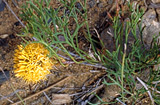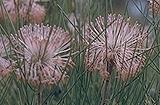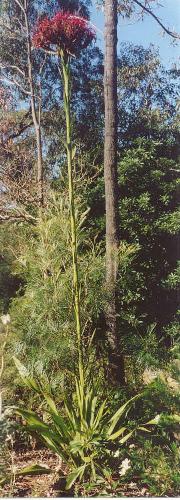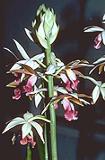|
[Front Page] [Features] [Departments] [Society Home] [Subscribe]

Short Cuts
Short items of interest about Australian plants selected from the many newsletters and journals published by member Societies of ASGAP.......
Short Cuts in this issue:
 19th Century Skullduggery!! 19th Century Skullduggery!!- The genus Isopogon reveals some unsavory activities in the early 1800s
 Gymea Silly Gymea Silly- An innovative approach for this reluctant flowerer!
 Rare Eucalypts at Burrendong Arboretum Rare Eucalypts at Burrendong Arboretum- Burrendong Arboretum, near Wellington, NSW, is the home of many rare and unusual species.
 Our Magnificent Swamp Orchids Our Magnificent Swamp Orchids- Two members of the genus Phaius which are becoming rare in their natural habitat
 Increasing the Variety of Birds in the Garden Increasing the Variety of Birds in the Garden- Planting techniques to provide suitable habitat
 The Genus Regelia The Genus Regelia- A small genus of Western Australian plants closely related to Melaleuca

19th Century Skullduggery!!
So you thought that Botany was a fairy sedate science! As David Lightfoot reports, plagiarism, ostracism and backstabbing were not uncommon during the Botanical Age of the early 19th Century....
The genus Isopogon is suffixed R.Br. ex Knight and the type species of the genus is I.anemonifolius (Salisb.) Knight. These suffixes point to a scandalous and rather controversial episode in the history of Botany.
The "R.Br"., of course, refers to Robert Brown (1773-1858) the botanist on Matthew Flinders' circumnavigation of the continent. The "Knight" refers to Joseph Knight (1777-1855), a gardener and horticulturist who was one of the first Europeans to grow Proteaceae. He was the gardener of George Hibbert, an MP of the time whose gardens were larger than Kew Gardens! "Salisb." refers to Richard Anthony Salisbury (1761-1829), a botanist and correspondent of Joseph Banks, who by all accounts, had a very difficult personality. After one of his public feuds, the big players in Botany at the time (including Banks and Brown) let it be known that as far as possible Salisbury's work and names were to be ignored. Indeed, a number of genera he named were later named something else.
 |
|
The genus Isopogon includes many species worthy of cultivation.
Isopogon prostratus (top) is found in scattered locations in New South Wales and Victoria while Isopogon divergens (bottom). occurs in south Western Australia.
Select the thumbnail image or highlighted name for a higher resolution image (50k and 36k).
Photos: Brian Walters; Australian Plants Society
|
 |
In January 1809 Robert Brown, at the meeting of the Linnaean Society of London, read his landmark paper "On the Proteaceae of Jussieu", in which he detailed his classification of the family and many new species were described. This meeting was attended by Salisbury. Brown was delayed in actually publishing his work until 1810, however, later in 1809 Salisbury published a work entitled "On the cultivation of the plants belonging to the natural order of proteeae". He used his friend Knight's name as the author but the work was his. In the book he used a number of names and descriptions that Brown had used in his talk and Salisbury had "borrowed". Salisbury was accused of plagiarism and ostracised even further.
A large portion of Knight/Salisbury's work was thus ignored by the Botanical establishment in favour of Brown's work - to be later reinstated by the rules of the International Code of Botanical Nomenclature which give the earliest published name priority, and resulted in a large number of name changes amongst the Proteaceae.
It is clear that Salisbury was not as guilty as was made out. His work was long and detailed and was no doubt ready for publication anyway, but he did add some of Brown's work to his own with less than adequate acknowledgement. In the end he was forced to retire from Botany, and he died of paralysis (? a stroke) in 1829.
So how does this relate to those suffixes? Well, Knight first named Isopogon from one of Robert Brown's manuscripts, thus the "ex". Salisbury was the first to publish (in 1796) the description of I.anemonifolius but incorrectly called it a protea (Protea anemonifolia). Knight's generic name is the correct one and so Salisbury is bracketed before Knight. The only question remaining is; was that Knight himself or Salisbury using Knight's name?
From from the newsletter of the Isopogon and Petrophile Study Group, November 2001.
[ Return to Index
]

Gymea Silly
When Brian Roach isn't making eloquent closing arguments in the courts of our land, he writes a regular column in a district group newsletter of the Australian Plants Society. This approach to flowering Gymea lily might be of interest - even if there's possibly more "folklaw" than 'law' involved...
The experts in these things tell us that 'foliage contrast' is a cornerstone of good garden design. For native plant enthusiasts who are often collectors first and landscapers second, that design criterion is often achieved more by good luck than good management. Fortunately we're driven to adorn our gardens with kangaroo paw (Anigozanthos), Patersonia and the like and in doing so, provide that much needed contrast of strappy foliage. On a larger scale there's the swamp lily (Crinum pedunculatum) and the Gymea lily (Doryanthes excelsa). The latter must be rated as one of our most dramatic native plants when in flower. The soccer ball sized red 'flower' atop the 4 metre or so high stem is simply stunning. Little wonder it's one of the most readily recognized native plants in the wider community, even though it's sometimes confused with the waratah.
 |
|
But while kangaroo paw, Patersonia and the swamp lily produce their floral beauty with annual regularity, not so the Gymea lily. I've searched for a word to describe its rate of flowering; intermittent, spasmodic or irregular all seem to overstate the position. Its reluctance to flower has been well illustrated in my own garden.
About 20 years ago I planted three. Until recently only one had flowered and that was in the late seventies. About 12 months ago I let out a whoop of glee when one of the two that had produced nothing, sent up a flower spike (shown in the photo at left). Even now the spent flower head still attracts attention. This 'recent' flowering started me thinking yet again about the dilemma. Surely there must be a way to trigger flowering. After all, it's nothing more than a plant's reproductive process. Why does the Gymea lily have to be so smug and disinterested in sex?
Somewhere in my mind's deep recesses I recalled reading or being told about a theory regarding how to stimulate flowering. I was prepared to try anything. Three or four months ago I put the theory into effect and crept up on my two that were arrogantly sitting there doing nothing. While I had some sympathy for the one that had flowered about 13 years ago (it was still recovering), it was outrageous conduct on the part of the other 20-year-older. I pulled apart the central section of the strappy leaves and dropped a rough, sandstone pebble, about the size of a 20 cent coin, into each one. I firmly pushed and prodded each pebble down with a stick until it would go no further. The theory is that the irritant of the pebble should set the reproductive process in motion.
And now - EUREKA!!! Both are sending up flower spikes. I reckon that's proof beyond reasonable doubt. Perhaps other growers can give the theory a try and let me know the results.
From "Blandfordia", the newsletter of the North Shore Group of the Australian Plants Society (NSW).
[ Return to Index
]

Rare Eucalypts at Burrendong Arboretum
Many members of the Australian Plants Society would be familiar with Burrendong Arboretum, as they have been valued supporters over the years. However, Netta Holmes thought there would be a number of others that may be interested in finding out more about this valuable and fascinating botanic garden
Established in 1964, Burrendong Arboretum has one of the largest collections of Australian plants in cultivation in New South Wales, covers 167ha of undulating country near Wellington, and has magnificent views overlooking the Lake Burrendong - a great place to visit within easy driving distance of Sydney, Newcastle and Canberra.
Burrendong Arboretum has proven to be especially successful at growing plants from Western Australia and areas of lower rainfall, and so has many spectacular species, including rare and endangered species, not seen in other Botanic Gardens in eastern Australia. There is always something of interest to visitors, but from late winter to early summer, the Arboretum explodes into colour as the grevilleas, hakeas and wattles bloom. There is a corresponding increase in the cacophony of birdsong, as flocks of Honeyeaters, Friarbirds, Noisy Miners and Wattlebirds feed in the shrubs.
I would like to share with you three of my favourite plants for an early summer visit. On a north-facing slope are the Western Beds, with plantings of Dryandra, Eremophila, Grevillea and many other species from arid Australia. Above these, are 4 groups of Eucalyptus - including some of my favourite rare Eucalypts that flower from spring to mid-summer.
E.rhodantha is a low-growing mallee that can look rather unremarkable until you see it flowering. It has silvery-blue, sessile leaves on spreading branches, a little like a smaller version of the E.macrocarpa. From early winter, you can see buds developing along the branches in the axils of the leaves, and they can have an extended flowering season right through winter and spring to early summer. The flowers themselves are magnificent - deep rich crimson stamens tipped with golden anthers above a powdery-grey cup. These blossoms are of good size - even up to around 50 mm across - and are easily seen on the small mallee.
This rare eucalypt grows naturally only in a very restricted area in the Western Australian wheatbelt in scrubland on grey sandy soil. It is known only from a few remnant patches.
These striking plants are a feature that should not be missed at Burrendong Arboretum. Rising from a lignotuber, the upper section of their branches are clothed with silver-grey, sessile leaves. These branches reach out at all angles, and are up to 6 metres high - the strange shapes look prehistoric or Martian! The flowers and fruit are the largest of any eucalypt, up to 75 mm across, and are impressive at any stage. Some flowers can usually be seen at most times of the year, but the main flowering is around October to December. The flowers range from yellow through salmon-pink to a bright deep red, the latter particularly spectacular against the grey-blue leaves.
This species is also from Western Australia, and grows in sandy soils through the wheatbelt area.
Eucalyptus peltata ssp Ieichhardtii - Rusty Jacket
These magnificent trees are bloodwoods, and so are part of the controversy surrounding the splitting of the Eucalyptus genus into a number of different genera. So some will call these Corymbia peltata ssp leichhardtii.
There is a grove of the rusty jackets at the end of the Western Beds. The common name is very apt, and describes the deep rusty orange of the flaky bark. They are a shapely tree, with a tall, straight trunk and weeping branches of dark green, peltate leaves. To see these trees of a late afternoon, with the low sun striking the rusty trunks and the leaves highlighted against a deep blue sky, is unforgettable.
The flowers add another dimension to the rusty jacket. Being a bloodwood, the flowers are massed on terminal panicles, covering the tree with clouds of creamy-white blossom. These are summertime flowerers, from December to February. These trees successfully set seed, as is evidenced by the seedlings growing around the parent trees.
Rusty jckets are found naturally on the Great Dividing Range, north of the Tropic of Capricorn in central and northern Queensland. They grow in open forest and woodlands on slopes.
So come and visit us at Burrendong Arboretum - there are many beautiful and interesting Australian plants we would love to share with you!
From the October 2001 issue of "Native Plants for New South Wales", the newsletter of the Australian Plants Society (NSW).
[ Return to Index
]

Our Magnificent Swamp Orchids
Species in the genus Phaius are becoming rare in the wild due to both habitat loss and illegal collecting. They are amenable to cultivation and, as John Moye describes, easily propagated.
The terrestrial orchid species, Phaius tancarvilliae and Phaius australis, are both listed as 'vulnerable' in the listing of 'Rare and Threatened Australian Plants'. However, a recent survey conducted by the National Parks and Wildlife Service, North Coast Region (NSW), concludes that Phaius tancarvilliae could now be extinct in that area, and that the colonies of P.australis are small and isolated, and could easily suffer a similar fate. P.australis is restricted to north-eastern NSW and south-eastern Queensland, so that the loss of wild populations will lead to the extinction of this species in the natural environment.
Locally, the genus Phaius is represented by the above species, which have both been given the common name of Swamp Orchids. One other species occurs in Australia - P.pictus is endemic to north-eastern Queensland.
As the common name indicates, Phaius are plants of moist to wet soils and grow in swamps, grasslands and forests where these conditions are to be found. On the North Coast of New South Wales the species are almost universally restricted to the coastal swamplands. The drainage of these areas for agriculture, for urban development and associated roadways, airports, canals and golf courses, has severely reduced the extent of these environments, leading to the loss of entire plant communities. The demise of the swamp orchids has been accelerated by the illegal collection of wild plants.
Both of the local species have large, very colourful and attractive flowers. Many people contend that Phaius tancarvilliae is Australia's most attractive orchid species. Plants are free-flowering and may have from 4 to 16 flowers per stem (which could be up to 1.5 metres tall). One specimen on show at a meeting of the Australian Plants Society had 31 flowers on 4 stems. Each of these flowers had a diameter of approximately 13cm.
 |
|
| Phaius tancarvilliae |
Select the thumbnail image or plant name for a higher resolution image (29k)
Photo: Keith Townsend |
|
These orchids are generally easy to grow in pots. They are shade-lovers and require humid. airy conditions. A mixture which contains some sharp sand, rich in humus and free draining, is required. This mixture should not be allowed to dry out, so regular watering is required. During the summer months, pots containing plants should be placed in shallow saucers of water.
Container-grown plants appreciate a regular application of weak solutitions of a soluble plant fertilizer (eg. Aquasol) or applications of Dynamic Lifter pellets two or three times a year. Maintain the soil level by additional organic material as required.
Over the years, I have provided numerous plants of Phaius tancarvilliae as raffle plants. These have been grown by treating flower stems after the flowers have dropped. Two methods have been used. Both involve the removal of the entire flower stalk and cutting it into segments.
One method requires segments of one or two nodes. These are placed in a container of water deep enough to completely cover the nodes, but leaving the upper stalk above the water level. Tiny plants develop at the nodes underwater. The segments can be removed and potted up when it is thought that sufficient root and leaf development has occurred.
The second method involves placing the cut lengths on moist sphagnum moss in warm humid conditions. These conditions can be achieved either in a commercial propagating house (if available) or by making a mini hothouse using a styrene box with a glass or clear plastic cover. Plant segments, each of one node, may also be 'struck' in a cutting mix (50/50 coarse sand/ sphagnum moss) in similar environments.
I have tried to grow plants in the bush on our property, but without success. However, it is possible to grow Phaius in garden situations, provided suitable environmental conditions can be achieved....there is a magnificent specimen of P.tancarvilliae in the Coffs Harbour Botanical Gardens and I know of one local plant enthusiast who has a similar plant growing happily in red soil.
From the newsletter of the Far North Coast Group of the Australian Plants Society, November 1994.
[ Return to Index
]

Increasing the Variety of Birds in the Garden
Attracting birds to the garden is one of the main objectives for many gardeners - but there are pitfalls....as Peter Olde explains.
Urban gardens in cities throughout Australia are no longer attracting the variety of bird species that they once did. This particularly applies to the smaller, less aggressive birds.
Lovers of Grevillea have long planted members of the genus in their gardens because they bring the birds. I must confess that this was myintroduction to the genus. However, it seems that this is a somewhat simplistic ideal because it fails to take account of bird dynamics and social structure. Perhaps we should be giving more consideration to the kind of birds the plants attract than to the actual species/hybrids that we plant.
In Sydney, birds that have declined include species such as Silvereyes, Eastern Spinebills and other various small honeyeaters. Larger species have increased including Wattle Birds, Pied Currawongs, Noisy Miners and Rainbow Lorikeets. The cause of bird decline in some species relates to the decline and increased distance of natural bushland areas from urbanised areas.
As urban development expands, fewer native birds seem to make the distance from the bush to garden. However, changes in garden structure, methods and plant choice directly affect the variety and composition of bird species in the garden. Current practices have resulted in an explosion of aggressive bird species and a reduction in smaller, less aggressive ones. The simplification of garden structure by the use of fewer, longer flowering plants (such as tropical grevilleas) has created ideal conditions for more aggressive, territorial bird species such as Noisy Miners, Wattle Birds or New Holland Honeyeaters which actively chase other birds away.
Once they have found a habitat with abundant food that can easily be defended, they set about claiming it as their own and begin driving away all competitors. Not only that, instead of migrating to other areas as food sources dry up, they become sedentary, preventing other migratory species from dropping in for a fill up.
To redress the balance, we can reduce the size and amount of open area in the garden through which aggressive birds can mount their attacks. Break up the open spaces. Add smaller, pricklier species in clumps, and introduce some species which have flowers that produce less nectar as these can be probed in safety by smaller birds.
Eastern Spinebills for instance will use Grevillea mucronulata and Grevillea pimeleoides for nectar whereas larger birds do not. The nectar reward is only small but worthwhile for smaller birds, which are far moreopportunistic, taking small doses where they can.
A mixture of tall and small plant species provides protection for small birds from the fast-flying, intimidatory tactics of Miners and others. These birds do not like to fly quickly through plants as they probably fear hitting their wings and thereby become less efective in marking out a territory.
Other factors to consider:
- Plan to cover the area from the ground (using ground covers) to the lower branches of taller plants using small, medium and tall sub-shrubs. Do not forget to plant some local species too as these are an important dynamic in any plant-bird interaction.
- Vary the width of the garden. Narrow gardens offer less protection than wide ones.
- Try to plan for at least one large, densely planted area. You just might find small birds nesting there.
- Do not plant shrubs that set fleshy fruits as these are attractive to Pied Currawongs. This is one of our most aggressive bird species and is notorious for predating eggs and nestlings of smaller bird species.
- Do not feed kookaburras as these also find small nestlings edible. They can easily be induced to a sedentary lifestyle too.
- Avoid insecticides in the garden. A garden full of birds should not need it.
- A bird bath can be a good thing provided it has clean, cool water and is set above ground or in a position that provides good visibility and warning from sudden attack by cats. Place it under a tree well away from the trunk or proximal to a dense Grevillea such as G.shiressii.
- Birds love the sprinkler too especially in summer when they will dive among the foliage and water drops. However, artificial nectar feeders tend to attract aggressive bird species and seed trays may also attract introduced birds.
- Food supply areas must be kept clean; if not, they can introduce disease to birds and may cause imbalances in their diets.
From the October 2001 issue of the newsletter of ASGAP's Grevillea Study Group.
[ Return to Index
]

The Genus Regelia
Regelia is a small genus which is closely related to Melaleuca, Beaufortia and Eremaea but they are not seen in cultivation as often as they deserve. Colin Cornford reports....
There are 6 species in the genus Regelia - 5 from south west Western Australia and 1 from the sandstone escarpments of Arnhem Land in the Northern Territory. The genus was described by Schauer in 1843 from specimens collected by Preiss from the Vasse River area and from James Drumrnond . The genus consists of small to large woody shrubs with small, opposite or spirally arranged leaves , usually slightly hairy. Brief descriptions of the species within the genus are as follows.
- Regelia ciliata - grows in sandy and silty soils in the Moore and Vasse River areas of south-west WA. it can grow to a height of 2 metres with a similar spread. Dense heads of mauve flowers are produced over a fairly long period during spring and summer.
- Regelia cymbifolia - grows in a restricted area in south-west WA in grey or yellow sands in sandplain or Eucalyptus wandoo woodland . This is a bushy erect shrub to 2 metres in height with tiny, dark green ovate leaves. Terminal deep pink to purple flowers are produced in small clusters in spring.
- Regelia inops - a small open shrub, widely distributed on sandy soils in the south-west of WA, which may be from 60 cm to 2 metres in height with tiny leaves pressed to the stem. The mauve flowers, which may be terminal or carried on small lateral branches are seen in late spring.
- Regelia megacephala - a tall, straggly shrub to 3.5 metres high with a spread of 1 metre or so. It grows on rocky quartzite hills in the south-west of WA. Heads of mauve flowers some 1.5 cm in diameter are produced in late spring.
- Regelia punicea - this plant was previously known as Melaleuca punicea. It grows on the sandstone escarpments of Kakadu National Park and is a tall spreading shrub to a height of 2.5 metres with a spread of some 3 metres. Small leaves, about 1.5 mm long, are spirally arranged around the stems . Terminal red flowers are seen during the dry season from June to August.
- Regelia velutina - found on quartzite rocky slopes in south-west WA overlooking the Southern Ocean it may be an erect or spreading shrub to 3 metres. Terminal spikes of red flowers , tipped with yellow anthers, up to 4 cm long are produced during spring. This is a very spectacular shrub when in flower.
From the newsletter of ASGAP's Melaleuca and Allied Genera Study Group, December 2001
[ Return to Index
]

[Front Page] [Features] [Departments] [Society Home] [Subscribe]
Australian Plants online - March 2002
Association of Societies for Growing Australian Plants
|